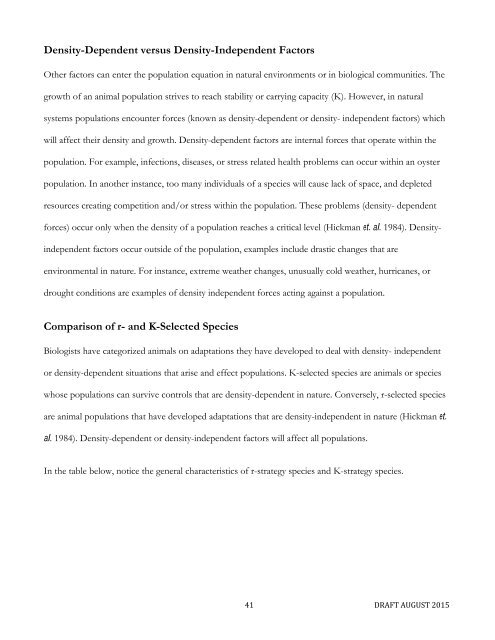Adopt-A-Wetland
XQDrg
XQDrg
You also want an ePaper? Increase the reach of your titles
YUMPU automatically turns print PDFs into web optimized ePapers that Google loves.
Density-Dependent versus Density-Independent Factors<br />
Other factors can enter the population equation in natural environments or in biological communities. The<br />
growth of an animal population strives to reach stability or carrying capacity (K). However, in natural<br />
systems populations encounter forces (known as density-dependent or density- independent factors) which<br />
will affect their density and growth. Density-dependent factors are internal forces that operate within the<br />
population. For example, infections, diseases, or stress related health problems can occur within an oyster<br />
population. In another instance, too many individuals of a species will cause lack of space, and depleted<br />
resources creating competition and/or stress within the population. These problems (density- dependent<br />
forces) occur only when the density of a population reaches a critical level (Hickman et. al. 1984). Densityindependent<br />
factors occur outside of the population, examples include drastic changes that are<br />
environmental in nature. For instance, extreme weather changes, unusually cold weather, hurricanes, or<br />
drought conditions are examples of density independent forces acting against a population.<br />
Comparison of r- and K-Selected Species<br />
Biologists have categorized animals on adaptations they have developed to deal with density- independent<br />
or density-dependent situations that arise and effect populations. K-selected species are animals or species<br />
whose populations can survive controls that are density-dependent in nature. Conversely, r-selected species<br />
are animal populations that have developed adaptations that are density-independent in nature (Hickman et.<br />
al. 1984). Density-dependent or density-independent factors will affect all populations.<br />
In the table below, notice the general characteristics of r-strategy species and K-strategy species.<br />
41 DRAFT AUGUST 2015



